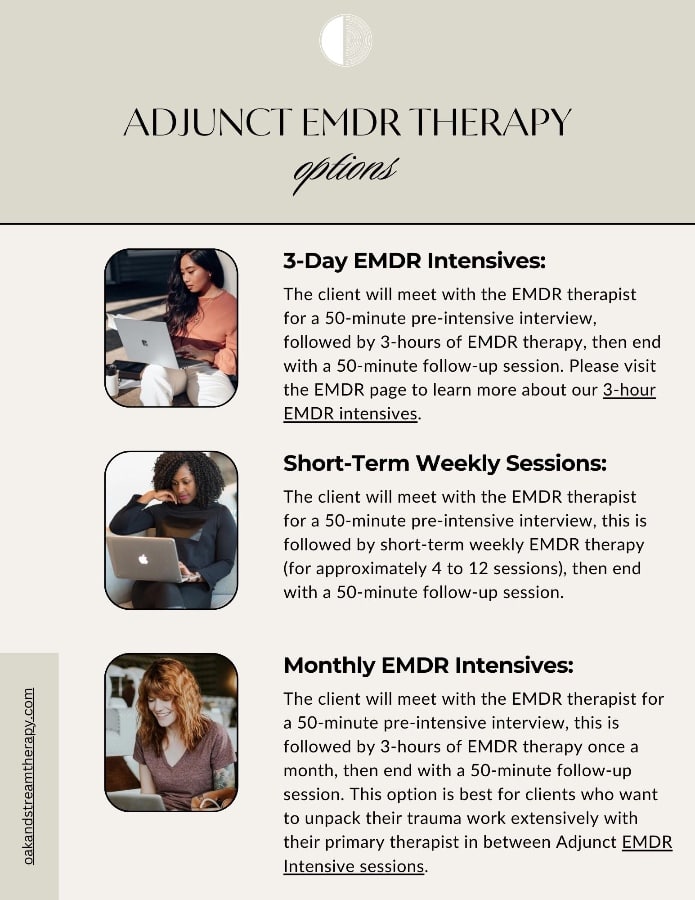Adjunct EMDR therapy
Sometimes it takes a village, so let’s collaborate and create a circle of care!
What is Adjunct EMDR therapy?
Adjunct EMDR therapy is a collaborative therapy option. It’s where a client and their primary therapist choose to get specialized support around issues like PTSD, and c-PTSD. As a clinician, you may have a client who has some underlying trauma presentations that may be impacting the progress you’re making with them and you’d like to get them some extra support. That’s where Adjunct EMDR therapy comes in. Adjunct EMDR therapy doesn’t replace their regular ongoing therapy with you. It’s simply a complimentary support to the work that you’re already doing with your client. How it works is that your client keeps on meeting with you for their regular sessions, and they meet up with me for some additional intentional EMDR support. Please note, Adjunct EMDR therapy is not a transfer of care.
When doing Adjunct EMDR therapy, it’s natural for clients to come back to you as their primary therapist to process what came up for them in their EMDR session. Please know, that is very much encouraged. This allows them to integrate their new self discoveries, chat about any reflections they’ve had, and set goals around behaviours they’d like to change as a result of processing their trauma.
Who is a good fit for Adjunct EMDR therapy?
This is a good fit for clients with whom you have a good rapport, clients who are able to effectively utilize self-regulation strategies, and who currently have a stable living environment. In addition to this, they need to not have any active substance abuse issues, and not engage in self-injurious behaviour. The client needs to have a clear target memory, stuck point, or recent adverse event they’d like to work through. Finally, they must have an interest in doing this kind of trauma processing work.

Benefits of Adjunct EMDR therapy!
Adjunct EMDR therapy is a good fit for clients who would like to get relief from:
- PTSD symptoms
- Betrayal Trauma symptoms
- Upsetting thoughts
- Intrusive images
- Negative beliefs
- Traumatic memories
- Flashbacks
- Support to install positive cognitions and beliefs
Adjunct EMDR therapy 5-step process:
- The primary therapist decides with their client that this is a good supplement to their current therapy and obtains a Release of Information from the client. Their primary therapist then reaches out to me for Adjunct EMDR support by booking an Adjunct EMDR Free 20-minute Virtual Consultation.
- The primary therapist and EMDR therapist meet and converse about the potential referral and come up with a strategic plan around what targets we should consider for EMDR processing. Please note, Adjunct EMDR is to help support your amazing work with your client.
- The client then books a New Client, Free 20-minute Virtual Consultation call so they can meet with the Adjunct EMDR therapist to discuss what they would like to process. The Adjunct EMDR therapist will then provide some psychoeducation about EMDR treatment and process, and the roles of both therapists in the circle of care.
- The client then makes a 50-minute pre-intensive interview appointment with the Adjunct EMDR therapist by clicking on this link: Individual Therapy – Virtual. At this appointment, the client and the Adjunct EMDR therapist will decide on the best strategic therapy option and book the session.
- The client will then have their chosen Adjunct EMDR therapy session(s). Afterwards, they will have regular check-ins with their primary therapist about anything that came up in the sessions. Please note, the primary therapist will be the client’s main support.
Is Adjunct EMDR therapy a good fit for you and your client?
If you have a client with whom you’ve built a good rapport, and you’d like some support in helping them access their traumatic memories and reprocess those events so the feelings related to those events will be more manageable for them, Adjunct EMDR therapy may be a good fit for you.
To learn some of the basics about EMDR therapy, you can check out this blog post entitled: What is EMDR?
FAQs
Adjunct EMDR therapy is where a primary therapist invites an EMDR trained therapist into the circle of care to help support their client in processing specific adverse experiences or traumas.
No, the Adjunct EMDR therapist simply comes alongside and complements the client’s ongoing therapy with their primary therapist. Think of Adjunct EMDR therapy as a supplementary support to the existing therapy that the client is currently doing.
This is something you as the primary therapist must discuss with your client. You need to consider your client’s therapeutic goals, whether they are able to self-regulate, and if your client is open to integrating EMDR into their current treatment plan.
No, the adjunctive EMDR therapist will only discuss the client’s case with their primary therapist with the client’s signed release, and only at the client’s specific request.
This depends on the individual client and their specific needs and goals. Some clients will benefit from a shorter course of treatment that focuses on a specific target, while others would benefit from an extended treatment plan that helps them to process some deeper and more internalized adverse experiences.
If you have a primary therapist, please discuss Adjunct EMDR therapy with them. You can share this flyer with them: Adjunct EMDR therapy flyer. If you both decide that Adjunct EMDR therapy would be beneficial to you, please have your primary therapist reach out by clicking on the button below.
Let’s collaborate in order to help your client to thrive. Book a free 20-minute consultation by clicking on the button below.


